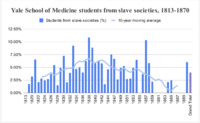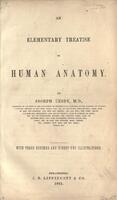-

This spreadsheet of Yale School of Medicine students and faculty from 1813 to 1870 (except for 1816) was compiled from the published school of medicine and university catalogues by Sean Morey Smith as part of the Yale School of Medicine and Slavery project.
-

Page 2 of Peaslee’s letter, second paragraph begins his description of the encounter with the Amistad Africans.
-

Entry for Carlos Fernando Ribeiro in the Catalogue of the Calliopean Society : Yale College, 1839
-

Excerpt from Account books of the Medical Institution of Yale College showing a payment to Knight for the anatomical preparations that Knight had obtained while studying medicine in Philadelphia.
-

Chart of percentage of Yale School of Medicine students from slave societies, 1813-1870. Created from the annual medical school catalogs which included lists of students and where they came from. Students from states and countries where slavery was legal at the outbreak of the Civil War were counted in comparison to the total number of students listed in the catalogs.
-

First page of the Connecticut Constitution of 1818. This Constitution declared "That, all men when they form a social compact, are equal in rights," but limited future voting to "white male citizen[s] of the United States."
-

Title page of William Henry Ealbeck's 1860 medical school thesis, "A Dissertation on Lethargus or the Sleepy Disease," written while a student at Maine Medical School at Bowdoin College
-

Portrait of Richard Henry Greene in uniform. Greene graduated from Yale College in 1857 before attending Dartmouth Medical School, where he earned his MD degree in 1864. Original tinotypes are the property of Lisa Senecal Moseley, Greene's great great granddaughter.
-

Hooker, professor of anatomy and physiology at the Medical Institution of Yale College, asks Welles, warden of the Connecticut State Prison in Wethersfield, that if any death in the prison occurs, to give us "timely notice," as according to a state statute. Hooker is seeking bodies for teaching [i.e. dissection].
-

Illustration entitled "The Negro in His Own Country" from Josiah Priest's Bible Defence of Slavery (1853). Depicts a shirtless Black man sitting on a rock and holding a spear. A human skeleton and palm trees are in the background.
-

“Cinque The Chief of the Amistad Captives,” painted by Nathaniel Jocelyn; engraved by J. Sartain. Philadelphia: 1840.
-

Photograph of the William Pinto House in 2020 at its original location of 275 Orange Street in New Haven.
-

Medical student Peter Woodbury’s notes from Nathan Smith’s lecture on sexual pleasure. "It makes no difference who we cohabit with; I mean the pleasures are the same, black or white; but it makes a material difference with whom we marry.”
-

Title page of James Austin’s 1845 MD thesis, "Dissertation on Remittent Fever."
-

Philo Nichols Curtis on race and intermittent fever, from his thesis: “Some years there is scarcely a white person escapes an attack of this disease for many miles in extent. The white population are more frequently the subjects of this as well as of every other disease peculiar to this section of country.”
-

Title page of R. La Roche's Yellow Fever, vol. 1 (1855)
-

Title page of Frederick Treadway's Yale School of medicine MD thesis entitled "A Dissertation on 'Yellow Fever.'"
-

Title page of Wood's A Treatise of the Practice of Medicine, vol. 1, 5th ed. (1858), assigned at Yale School of Medicine.
-

Title page of Joseph Leidy's An Elementary Treatise on Human Anatomy (1861), assigned at Yale School of Medicine.
-

Thomas Hubbard's lecture notes on "Hottentot" sexual characteristics. "The Hottentots in Africa, great enlargements of the female mammae are common^ Tis said they can nurse their infants when tied to their backs - They are said also to have surprizing enlongations of the Nymphae"
-

Drawing of a mill yard and water-powered sugar mill in Brazil with enslaved people unloading freshly cut cane. First published in Johann Moritz Rugendas, Voyage Pittoresque dans le Bresil. Traduit de l'Allemand (Paris, 1835; also published in same year in German).
-

Excerpts from Benjamin Silliman account books, 1806-1808, referencing the labor of "boys" and "servants." The people may have been free laborers, indentured servants, enslaved people, or formerly enslaved people.
-

Photograph of Phelps Halls and Lyceum from campus, in Yale's Old Campus. The Lyceum (center-right of this frame) was demolished in the early 1900s.
-

Page from Benjamin SIlliman account book for Yale College Laboratory and American Journal of Science and Arts, 1826-1841, showing his record of Yale college-related expenses for slave-holding South Carolinian student Thomas Legare, including the line item for $7 fee for Legare’s membership in the Calliopean Society.
-

Photograph of a statue of Benjamin Silliman in front of Yale's Sterling Chemistry Laboratory, sculpted by John Ferguson Weir in 1884.

























